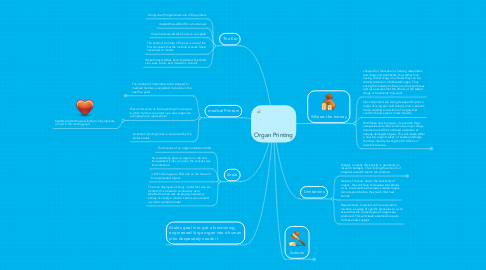Organ Printing
por Angel Ruiz


1. The Ear
1.1. Young-Joon Programmed one of the printers
1.2. created the scaffold for a human ear
1.3. the process would take hours to complete
1.4. The external structure of the ear is one of the first structures that the institute at wake forest have tried to master
1.5. Wake Forest staffers have implanted bi-printed skin, ears, bone, and muscle on animals
2. medical Printers
2.1. The number of 3d printers to be shipped to medicall facilities is expected to double in the next five years
2.1.1. Project specifications
2.1.2. End User requirements
2.1.3. Action points sign-off
2.2. These trials serve as the beginning of a new era in which humans can order up a new organ like a simple phone replacement
2.2.1. Experts predict the possibility to fully replicate a heart in the coming years
2.3. A vast bio printing future is envisioned by the professionals
3. Atala
3.1. The founder of an organ institute in 2004
3.2. he successfully grew an organ in a lab and transplanted it into a human, the process was time intensive
3.3. in 2011 Atala gave a TED talk on the future of bio engineered organs
3.4. The man displayed a kidney model that was bio printed, this created a controversy as to whether the man was displaying a working kidney or simply a model. Later is was cleared up to be a simple model
4. Atala's goal is to get a functioning, engineered large organ into a human who desperately needs it
5. Wheres the money
5.1. cheaper bio fabrication is helping researchers test drugs and treatments, thus rather than having to test drugs on animals they can be directly tested on a fabricated organ. Thus saving the industry millions in animal purchases and also assures that the effects of the tested drugs or treatments truly work
5.2. Skin cell printers are being designed to print a range of living skin cells directly onto a patient, hence creating a new form of surgery that could in theory sprout a new industry
5.3. With these new bi organs, its possible drug companies will suffer, since many major drugs revolve around the continued operation of already damaged organs. This will create either a new bio organ market, or severely damage the drug industry costing the US billions in possible revenue.
5.3.1. Included
5.3.2. Included
5.3.3. Excluded
6. Limitations
6.1. Budget, currently the industry is operating on research budgets. Thus limiting the amount of progress research teams can produce
6.1.1. Materials
6.1.2. Personel
6.1.3. Services
6.1.4. Duration
6.2. Delivery Timeline, due to the sensibility of organs, they will have to develop procedures so as to assure that the newly created organs do not expire before they reach their new homes
6.3. Requirements, hospitals will be required to maintain a supply of specific resources so as to assure that the correct types of organs are produced. This will create a demand vacuum for these new supply's
7. Actions
7.1. Define Project Schedule
7.1.1. Dependencies
7.1.2. Milestones
7.2. Limitations
7.2.1. Schedule
7.2.2. Budget
7.3. Define Project Development Measurement
7.3.1. KPI's
